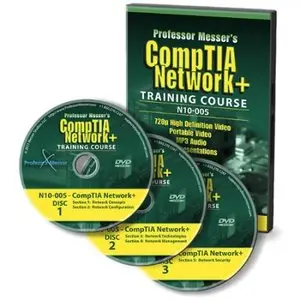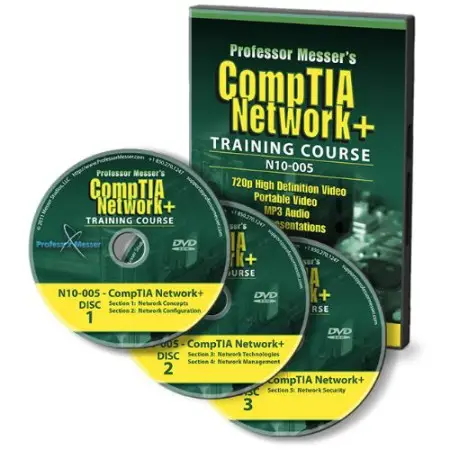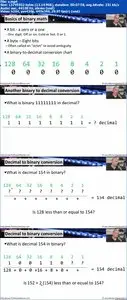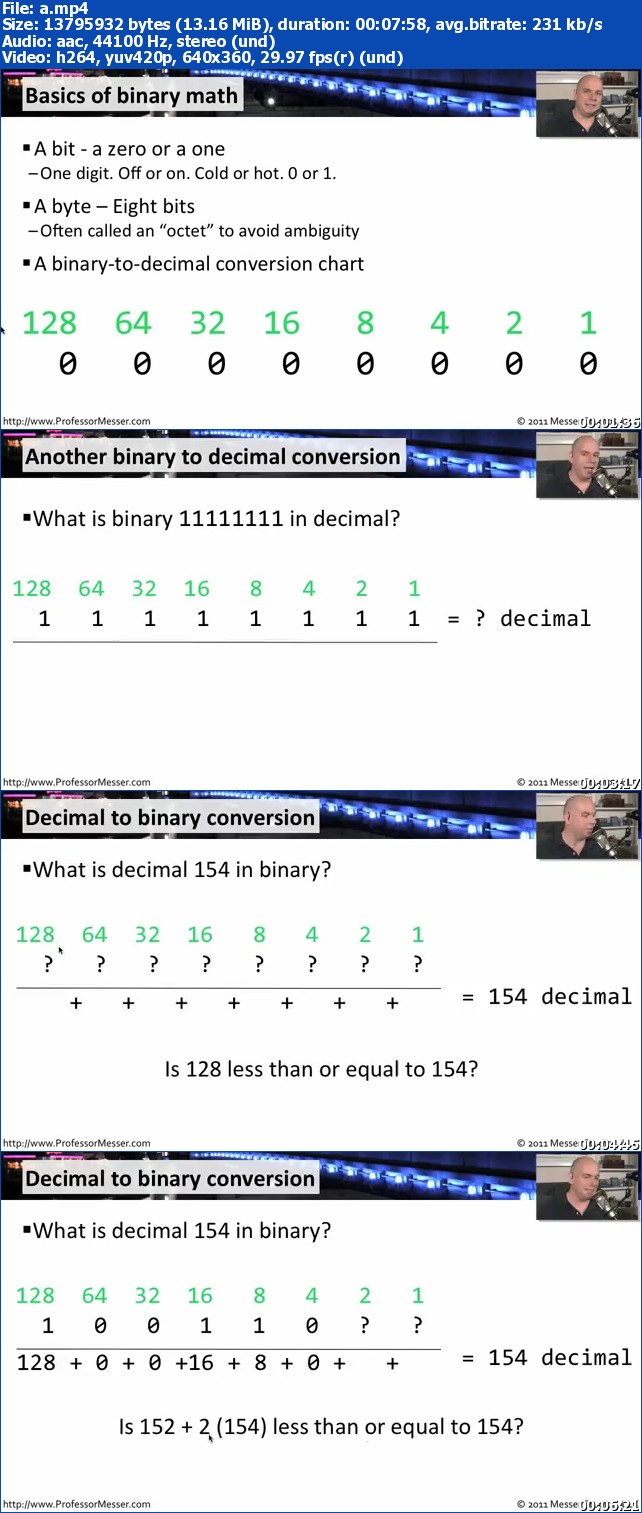Professor Messer’s CompTIA N10-005 Network+ Training
English | .MP4 | aac, 44100 Hz, stereo | h264, yuv420p, 640x360, 29.97 fps(r) | 2.72GB
Genre: E-learning
English | .MP4 | aac, 44100 Hz, stereo | h264, yuv420p, 640x360, 29.97 fps(r) | 2.72GB
Genre: E-learning
Section 1: Networking Concepts
1.1 – OSI and TCP/IP Models
The OSI Model (7:43) | The TCP/IP Model (5:00)
1.2 – Real-World OSI
The OSI Model in the Real World (6:00)
1.3 – IP Addressing
Binary Math (7:59) | IP Classes (9:52)
Classless Inter-Domain Routing (7:32) | IPv4 and IPv6 (5:18)
MAC Address Formats (6:46) | Subnetting (16:12)
Unicast, Multicast, and Broadcast (5:12) | APIPA (3:42)
1.4 – Routing and Switching
EIGRP (2:53) | OSPF (2:40) | RIP (2:21)
Link State, Distance Vector, and Hybrid Routing Protocols (5:38)
Static and Dynamic Routing (4:18) | Routing Metrics (3:50) | Next Hop (7:36)
Spanning Tree Protocol (6:00) | VLANs (4:08) | Port Mirroring (3:33)
Collision Domains and Broadcast Domains (7:00) | IGP and EGP (3:47)
Routing Tables (8:07) | Convergence (3:13)
1.5 – TCP and UDP Ports
Common TCP and UDP Ports (8:09)
1.6 – Common Networking Protocols
Networking Protocols (6:17) | Management Protocols (10:51)
Application Protocols (9:36)
1.7 – DNS
An Overview of DNS (8:12) | DNS Records (9:05)
Dynamic DNS (4:26)
1.8 – Network Troubleshooting Methodology
The Network Troubleshooting Process (9:23)
1.9 – Virtual Networking
Virtual Desktops and Servers (8:29) | Virtual Switches (3:50)
Network as a Service (4:41) | Onsite vs. Offsite Virtualization (4:13)
Virtual PBX (3:23)
Section 2: Network Installation and Configuration
2.1 – Installing Routers and Switches
Configuring Routing Tables (6:08) | Configuring NAT and PAT (4:58)
Configuring VLANs (3:50) | Managed vs. Unmanaged Switches (2:33)
Interface Configurations (3:26) | Power over Ethernet (3:45)
Traffic Filtering (3:34) | Switch and Routing Diagnostics (2:48)
VLAN Trunking Protocol (2:38) | Quality of Service (7:46) | Port Mirroring (3:32)
2.2 – Installing Wireless Networks
Access Point Placement (3:36) | Wireless Antenna Types (3:09)
Wireless Interference (3:05) | Wireless Channels and Frequencies (7:06)
Wireless Standards (6:04) | SSID Management (2:39)
Wireless Compatibility (2:51)
2.3 – DHCP
DHCP Addressing Overview (4:35) | DHCP Reservations (3:10)
DHCP Scopes (1:39) | DHCP Leases (4:24)
DHCP Options (3:03)
2.4 – Troubleshooting Wireless Problems
Troubleshooting Wireless Signal Issues (4:40)
Troubleshooting Wireless Configurations (3:12)
2.5 – Troubleshooting Routers and Switches
Troubleshooting Switch Loops (5:01)
Troubleshooting Network Cabling (4:24)
Troubleshooting Port Configuration (4:15)
Troubleshooting VLAN Assignments (4:20)
Troubleshooting Mismatched MTUs (9:15)
Troubleshooting Power Failures (4:32) | Troubleshooting Routing (6:13)
Troubleshooting Bad Fiber Modules (4:49)
Troubleshooting Subnet Masks and Gateways (4:30)
Troubleshooting Duplicate IP Addresses (4:52) | Troubleshooting DNS (4:05)
2.6 – Implementing a SOHO Network
SOHO Network Requirements (4:36) | SOHO Cabling (4:10)
SOHO Device Types (4:55) | SOHO Environmental Limitations (3:57)
SOHO Equipment Limitations (3:28) | SOHO Compatibility Requirements (3:34)
Section 3: Network Media and Topologies
3.1 – Media Types
Multimode and Singlemode Fiber (4:46)
UTP, STP, and Coaxial Cabling (5:53)
Cable Categories (3:34) | Crossover and Straight Through Cables (6:27)
Plenum and Non-Plenum Cabling (4:22) | Converting Media (5:10)
Media Distance and Speed Limitations (5:48)
Broadband over Powerline (3:53)
3.2 – Connector Types
Fiber Connectors (4:36) | Copper Connectors (10:29)
3.3 – Wireless Networking Standards
Covered in Section 2.2
3.4 – WAN Technologies
T1/E1 and T3/E3/DS3 (3:46) | OCx, SONET, and SDH (3:55)
Satellite, ISDN, Cable, DSL, and Dialup (10:25)
Cellular, WiMAX, LTE, and HSPA+ (4:54) | DWDM and PON (3:48)
Frame Relay and ATM (4:09) | Circuit Switching and Packet Switching (3:30)
Transmission Media, Speed, and Distance (4:34)
3.5 – Network Topologies
MPLS Networks (2:34) | Network Topologies (4:52)
Client Server and Peer-to-Peer Networks (2:47)
3.6 – Troubleshooting Physical Connectivity
Troubleshooting Bad Connectors (2:32)
Troubleshooting Opens and Shorts (2:46) | Troubleshooting Split Cables (3:08)
Troubleshooting dB Loss (6:18)
Troubleshooting Transmit-Receive Reversal (3:29)
Troubleshooting Cable Placement, EMI, and Interference (5:09)
Troubleshooting Crosstalk (4:16)
3.7 – LAN Technologies
Ethernet Topologies (7:32) | CSMA/CD and CSMA/CA (5:33)
Bonding and Link Aggregation (2:25)
3.8 – Wiring Distribution
IDF and MDF (3:33) | Demarcs and Smart Jacks (3:39)
CSU/DSU (2:55)
Section 4: Network Management
4.1 – Network Appliances
Load Balancers (4:10) | Proxy Servers (3:02)
Content Filters (4:46) | VPN Concentrators (3:36)
4.2 – Troubleshooting Tools
Crimpers (3:36) | Lineman’s Handset (2:53) | Toner Probes (3:06)
Punch Down Tools (3:53) | Protocol Analyzers (4:22) | Loopback Plugs (2:30)
TDR and OTDR (3:23) | Multimeters (2:12) | Environmental Monitors (2:28)
4.3 – Software Tools
Using Protocol Analyzers (4:31) | Throughput Testers (3:51)
Ping (5:16) | Traceroute (5:56) | Nslookup and Dig (4:45)
Ipconfig and Ifconfig (6:07) | ARP (4:02) | Nbtstat (2:52)
Netstat (4:55) | Route (5:07)
4.4 – Network Monitoring
SNMP (6:40) | Syslog (4:12)
Using Traffic Analysis (4:21)
4.5 – Configuration Management Documentation
Wire Schemes (3:27) | Network Maps (5:09)
Documentation (3:28) | Cable Management (3:20) | Asset Management (2:49)
Baselines (2:43) | Change Management (3:54)
4.6 – Network Performance Optimization
Optimizing Network Performance (3:58) | QoS and Traffic Shaping (5:08)
Load Balancing (4:49) | High Availability and Fault Tolerance (6:20)
Caching Engines (3:18)
Section 5: Network Security
5.1 – Wireless Security
Understanding WEP, WPA, and WPA2 (5:19) | MAC Address Filtering (3:01)
Device Placement and Signal Strength (2:29)
5.2 – Network Access Security
Access Control Lists (3:51) | Tunneling and Encryption (5:33)
IPsec (7:20) | Remote Access (7:10)
5.3 – User Authentication
Introduction to User Authentication (4:27) | Understanding PKI (6:05)
An Overview of Kerberos (7:09)
An Overview of AAA, RADIUS, and TACACS (3:49)
Network Access Control with 802.1X (3:50) | CHAP and MS-CHAP (2:53)
Understanding Extensible Authentication Protocol (2:47)
Multi-factor Authentication (2:54) | Single Sign-on (2:58)
5.4 – Common Threats
War Driving and War Chalking (3:32) | Cracking WEP and WPA (9:41)
Rogue Access Points and Evil Twins (4:03) | Denial of Service Attacks (5:42)
Man in the Middle Attacks (4:52) | Social Engineering Attacks (4:49)
Virus and Worm Attacks (6:26) | Buffer Overflow Attacks (3:49)
Packet Sniffing Attacks (4:20) | FTP Bounce Attacks (2:49)
End-User Security Training and Awareness (4:44) | Patch Management (3:16)
Policies and Procedures (3:02) | Incident Response (3:29)
5.5 – Firewalls
Software and Hardware Firewalls (3:37) | Stateful Inspection and Packet Filtering (2:42)
Understanding Firewall Rules (5:24) | Understanding NAT and PAT (5:48)
5.6 – Network Security Appliances
An Overview of IPS and IDS (4:33) | Vulnerability Scanning (4:58)
An Overview of Honeypots (3:34)
HomePage
Screenshot:
(Click to enlarge)
(Click to enlarge)





